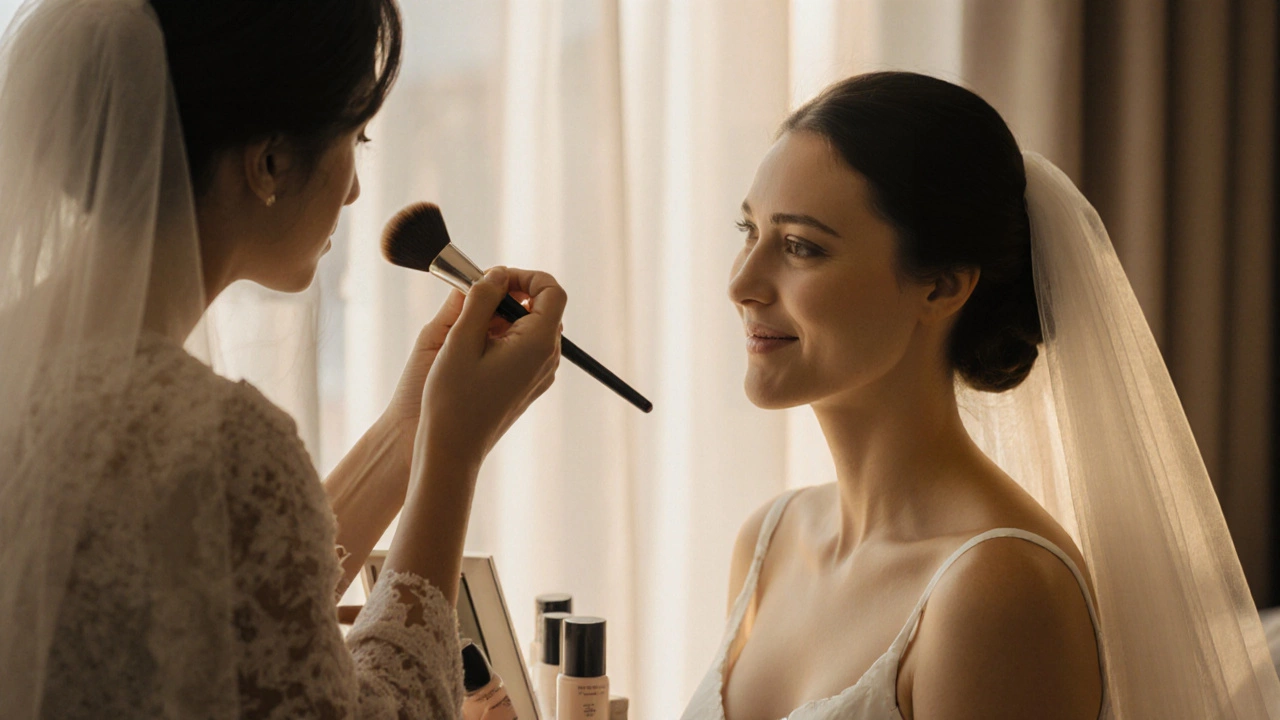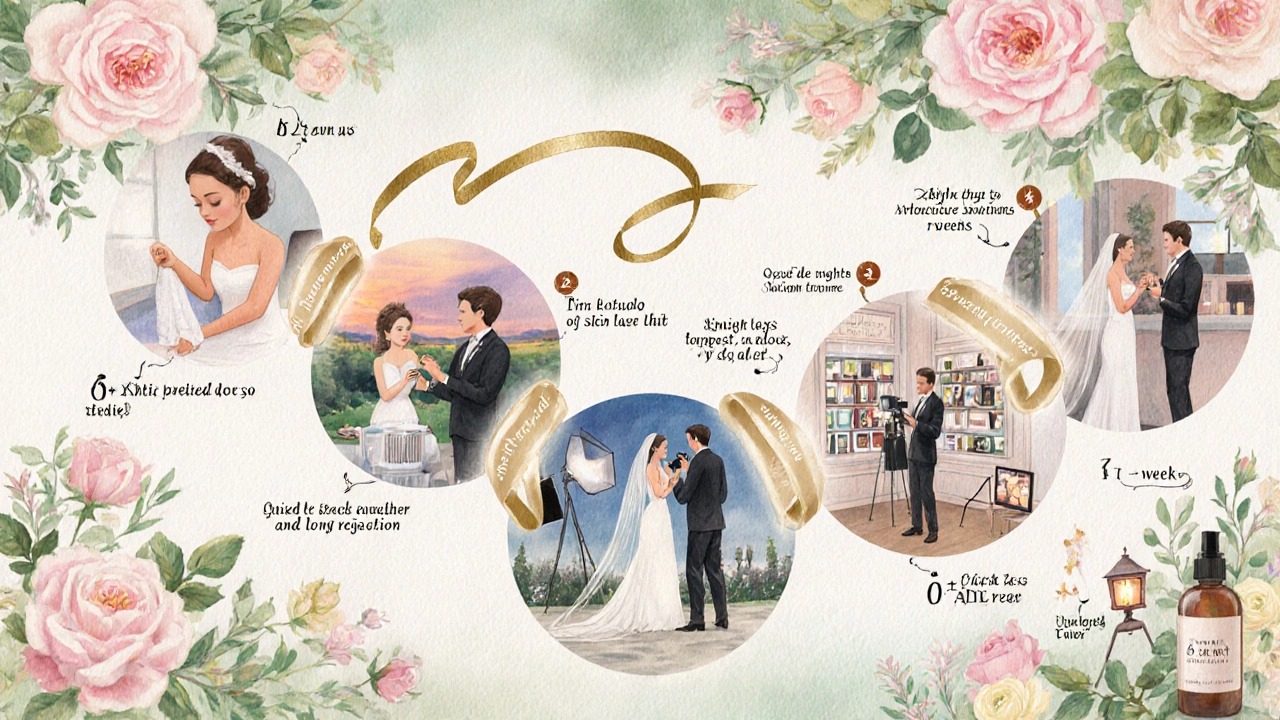When Should You Schedule Your Wedding Makeup? A Complete Timing Guide
 Oct, 17 2025
Oct, 17 2025
Wedding Makeup Timeline Calculator
Enter your wedding date to see the ideal makeup schedule for each phase of your planning.
When you plan a Bridal makeup is a customized beauty routine designed to keep the bride looking flawless from the ceremony through the reception. It combines long‑lasting products, skin prep, and technique tailored to the wedding day schedule and lighting conditions. Timing it right can mean the difference between a fresh glow and a faded look in those priceless photos.
Why Timing Matters More Than You Think
Most brides assume makeup is a "day‑of" task, but the truth is that the wedding makeup timing starts weeks before the aisle. The skin’s condition, the products you’ll use, and the photographer’s lighting all intersect. A well‑spaced timeline gives you room to test, adjust, and ensure nothing surprises you on the big day.
Key Factors That Influence Your Makeup Schedule
- Skin health: Oily, dry, or combination skin reacts differently to long‑wear formulas. Knowing your skin type helps you choose the right prep routine.
- Season and venue: Outdoor summer weddings call for sweat‑resistant, UV‑protective products, while winter indoor events allow richer textures.
- Photographer’s lighting: Natural light highlights texture; studio flash can flatten details. Your makeup artist should know the lighting plan.
- Desired look: A natural "no‑makeup" vibe needs different products than a glamorous, high‑gloss style.
- Travel logistics: If you’re traveling for the ceremony, factor in time‑zone changes that can affect skin reaction.
Recommended Timeline: From Weeks to Minutes Before the Vows
| Timeframe | What to Do | Why It Helps |
|---|---|---|
| 8-10 weeks | Start a skin‑care regimen (cleanser, moisturizer, sunscreen) | Build a healthy base; reduces flare‑ups during trial |
| 6 weeks | Schedule a consultation with your makeup artist to discuss look, products, and budget | Establish expectations and test product compatibility |
| 4 weeks | Begin applying a skin primer during evenings to gauge any reactions | Ensures primer won’t cause irritation on the day |
| 2 weeks | Do a full‑length makeup trial (including hair styling) for the pre‑wedding photoshoot | Captures how makeup looks under the exact lighting you’ll use later |
| 1 week | Finalize product list; purchase any long‑wear items you’ll need | Avoid last‑minute store trips that could delay the schedule |
| 2-3 days | Do a mini‑trial focusing on problem areas (e.g., oily T‑zone) | Fine‑tune foundation shade and setting spray amount |
| Day before | Apply a deep‑moisturizing mask; avoid heavy creams that could clog pores | Leaves skin refreshed and ready for makeup |
| Day of (morning) | Follow the exact routine practiced during trial - cleanse, moisturize, prime, base, color, setting spray | Consistency eliminates surprises and keeps makeup intact for hours |

Deep‑Dive: The Makeup Trial - Your Dress Rehearsal
The trial isn’t just a vanity session; it’s a technical run‑through. Here’s what to focus on:
- Lighting replication: Ask your photographer to bring the same lighting set‑up (e.g., golden‑hour natural light or studio softboxes) so you can see how foundation and highlighter behave.
- Full‑body look: Include hair, jewelry, and any veils. The interplay between these elements and makeup can shift the perceived color balance.
- Wear test: Stay in the makeup for at least 4‑6 hours - the typical length of a ceremony and reception - and note any fading, creasing, or shine.
- Product swap: If foundation oxidizes or lipstick puckers, request alternatives on the spot.
Essential Products for Long‑Lasting Bridal Beauty
Below are the must‑have categories and a quick tip for each:
- Foundation: Choose a matte, oil‑free formula with SPF 15‑30 to protect against outdoor glare.
- Concealer: Pick a shade one tone lighter than your foundation for under‑eye brightness.
- Setting spray: A hydrating mist adds a dewy finish; a locking spray prevents smudge in humid climates.
- Contour kit: Use subtle shading to define cheekbones - too harsh will look obvious in high‑resolution photos.
- Eyeliner: Waterproof gel stays crisp through tears and dancing.
- Lip stain: Provides color that won’t migrate onto the teeth.
Common Pitfalls and How to Avoid Them
- Skipping the skin‑care phase: Even the best foundation can cake on dehydrated skin. Stick to a regimen of cleanser, toner, serum, and moisturizer.
- Testing new products on the wedding day: Always use trial‑run products at least two weeks prior.
- Forgetting the setting powder on oily zones: A light dusting on the T‑zone prevents shine under flash.
- Rushing the trial: Allocate at least two hours; hurrying leads to missed details.
- Not coordinating with the hair stylist: Hair products can clash with makeup (e.g., too much hairspray causing facial product fallout).

After‑Care: Keeping Your Glow Through Reception
Even the strongest makeup benefits from a little TLC after the ceremony:
- Carry blotting papers to absorb excess oil without disturbing foundation.
- Refresh with a mist of setting spray during the reception break.
- Touch up lipstick with a clean brush and a small dab of lip stain.
Quick Checklist for Brides
- Start skin‑care 8‑10 weeks ahead.
- Book makeup artist consultation by week 6.
- Complete full trial 2 weeks before the wedding.
- Do a mini‑trial 2‑3 days before the day.
- Test all products for allergies at least 2 weeks prior.
- Pack an emergency kit (blotting papers, lipstick, setting spray).
Frequently Asked Questions
How many days before the wedding should I do my makeup trial?
A full‑day trial is best scheduled about two weeks before the ceremony. That gives you enough time to see how the products hold up and make any needed tweaks.
Can I do my makeup on the morning of the wedding?
Yes, but only if you’ve practiced the exact routine during your trial. Follow the same order - cleanse, prime, base, color, set - to avoid surprises.
What’s the best foundation type for a summer outdoor wedding?
Look for a lightweight, oil‑free, matte foundation with added SPF. It will resist sweat and prevent that dreaded flash‑back effect in photos.
Should I bring my own makeup products on the wedding day?
If you have a beloved product that works well with your skin, bring it. However, discuss it with your makeup artist first so they can blend it seamlessly with their kit.
How can I prevent makeup from creasing on my face?
Start with a well‑hydrated skin, use a silicone‑based primer on oily zones, apply foundation in thin layers, and finish with a setting spray. A gentle blot after the ceremony also helps.